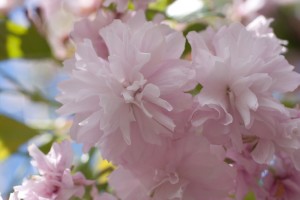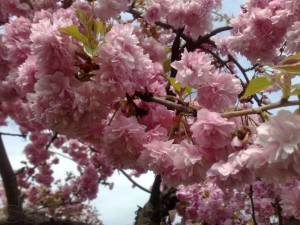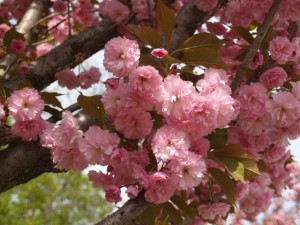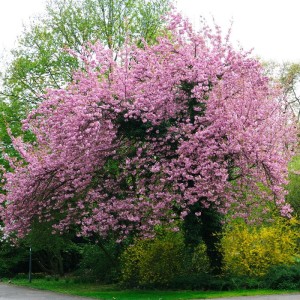Decorative Japanese cherry - decorate your garden
Sakura, an ancient symbol of Japan, will be a picturesque decoration of a garden plot, city park or alley. Many gardeners use it as a hedge, which adorns the garden in early spring and bears sweet fruits by summer. Today, many people mistakenly confuse decorative different varieties of not only cherries, but also plums, peaches or apricots, also classifying them as sakuras. No plant will provide such an original decor as this cherry.
Content
Varieties
Ornamental cherry is a complex name for forms derived from individual East Asian varieties, usually with pink, double flowers. Most sakuras are classified as serrated or sharp-serrated cherries. An adult tree in some species can reach 22-28 m in height. The leaves are large, bright green, in the autumn they acquire a purple, almost crimson hue. In the inflorescence there are about 6-8 flowers, small in size. The flowering period is early.
Often sakura is called the steppe felt cherry, which also blooms profusely in May, its decorative flowering bushes of pink or white color are a decoration of the garden area throughout the season.

Sakura kiku shidare
On the territory of Russia and Ukraine, the sakura variety kiku shidare is widespread. It belongs to finely sawed cherries. The height of an adult tree reaches 2.5-4 m. It has a spreading, spherical crown, prone to thickening. It has an average growth rate, the annual growth is about 25-35 cm. The leaves are large, elliptical, 7-9 cm long, arranged alternately on the branches.
The flowering period is early, late March - early May. This species is distinguished by abundant flowering. Large pink, densely double flowers, up to 5-7 cm in diameter, collected in numerous, dense inflorescences. Refers to self-fertile varieties, so this decorative cherry can be planted both singly and in groups.
The planting site should be sunny, since in a shaded area the tree will ache and bear fruit poorly. Prefers sandy-clayey, neutral or strongly alkaline soils. For abundant flowering, abundant moisture and regular feeding with superphosphates are necessary.

Kanzan
Ornamental Kanzan cherry is a tree-like, finely serrated cherry. It reaches a height of 8-10 m, has a spreading, reverse-conical crown. Leaves are large, elongated, oval, shiny, bright green in color. In autumn, the foliage takes on a fiery yellow hue. The growth rate is average.
The flowering period is average. The flowers are large, collected in long hanging inflorescences of 3-6 pieces, fragrant, terry, up to 25-30 petals, pale pink in color. Photophilous and prefers neutral or strongly alkaline soils. Average frost resistance. A detailed description of other forms of sakura can be read in special catalogs, familiarized with their appearance, planting and care features.

Landing
Decorative sakura cherry is very photophilous, therefore, for planting, it is necessary to choose a site that is well lit, without stagnation of excess moisture during spring thaws and autumn rains, preference should be given to small hillocks or embankments. The place should be protected from cold winds by a building wall or some kind of plant. Plants are planted at a distance of at least 1.5-2 m relative to each other and 2.4-3 m between rows.
Planting is best done in early spring, before the buds swell, but already at an established warm temperature, or in late autumn in October.It is better to plant several varieties or shrubs at once, this will ensure their abundant flowering, and the fruit ovaries will be much higher.
The landing pits are prepared in advance by placing a mixture of humus and a fertile top layer of the earth in them. Also, immediately before planting, it is necessary to add a solution of superphosphates and potassium sulfate to the pit, dissolving them in 15-18 liters of water. The root collar should be at ground level. After planting, the plant is watered and mulched with humus or peat with a layer of 4-5 cm.
In order not to damage the root system, further processing of the soil in the near-stem circle is carried out very carefully, shallowly loosened and weeds are removed. It is advisable to keep this area clean in the first few years after planting, so the plant will strengthen and grow stronger faster, without loss it will endure cold winters.

Care
Distinguish between varietal and wild sakura, the method of reproduction depends on it. Preference should be given to grafted seedlings. They are usually purchased in the fall and kept in a pot until spring in a humid place at room temperature. Plants should be with a matured trunk, 1-1.5 meters in height and a developed root system.
The soil must be well-drained and rich in nutrients. It should be noted that with a lack of nitrogen and potassium in the soil, it causes an acute reaction of cherries, the plant ceases to bloom profusely, sheds leaves early. In cases of soil depletion, it is necessary to apply humus or compost in the amount of 6-8 kg for each tree. Phosphorus and potassium are added at the rate of 15-18 g per 1 m2.
During the period of active growth, several abundant watering is carried out, and in the future, normal soil moisture is maintained, if natural precipitation is not enough, otherwise few buds will form and flowering will be scarce, and the flowers are small. Every year in early spring, before the onset of sap flow, pruning is carried out, removing excess branches that thicken the crown, dry or damaged branches.
All young trees must be covered for the winter, adult cherry blossoms are frost-resistant. Scion sites, stems and bases of large branches are wrapped with agrofibre or other covering material until the first frost. Chemical treatment of wood is carried out several times per season. In this case, the first spraying is carried out before bud break, and not during flowering, and the procedure is repeated 3-4 weeks after the ovary of the first fruits.
Video "Sakura - features of care."
The video covers in detail the main points of caring for an ornamental plant such as sakura. Reveals the secrets of the annual abundant flowering of trees.
